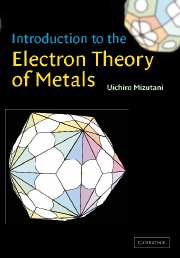Book contents
- Frontmatter
- Contents
- Preface
- 1 Introduction
- 2 Bonding styles and the free-electron model
- 3 Electrons in a metal at finite temperatures
- 4 Periodic lattice, and lattice vibrations in crystals
- 5 Conduction electrons in a periodic potential
- 6 Electronic structure of representative elements
- 7 Experimental techniques and principles of electronic structure-related phenomena
- 8 Electronic structure calculations
- 9 Electronic structure of alloys
- 10 Electron transport properties in periodic systems (I)
- 11 Electron transport properties in periodic systems (II)
- 12 Superconductivity
- 13 Magnetism, electronic structure and electron transport properties in magnetic metals
- 14 Electronic structure of strongly correlated electron systems
- 15 Electronic structure and electron transport properties of liquid metals, amorphous metals and quasicrystals
- Appendix 1 Values of selected physical constants
- Principal symbols (by chapter)
- Hints and answers
- References
- Materials index
- Subject index
1 - Introduction
Published online by Cambridge University Press: 20 November 2009
- Frontmatter
- Contents
- Preface
- 1 Introduction
- 2 Bonding styles and the free-electron model
- 3 Electrons in a metal at finite temperatures
- 4 Periodic lattice, and lattice vibrations in crystals
- 5 Conduction electrons in a periodic potential
- 6 Electronic structure of representative elements
- 7 Experimental techniques and principles of electronic structure-related phenomena
- 8 Electronic structure calculations
- 9 Electronic structure of alloys
- 10 Electron transport properties in periodic systems (I)
- 11 Electron transport properties in periodic systems (II)
- 12 Superconductivity
- 13 Magnetism, electronic structure and electron transport properties in magnetic metals
- 14 Electronic structure of strongly correlated electron systems
- 15 Electronic structure and electron transport properties of liquid metals, amorphous metals and quasicrystals
- Appendix 1 Values of selected physical constants
- Principal symbols (by chapter)
- Hints and answers
- References
- Materials index
- Subject index
Summary
What is the electron theory of metals?
Each element exists as either a solid, or a liquid, or a gas at ambient temperature and pressure. Alloys or compounds can be formed by assembling a mixture of different elements on a common lattice. Typically this is done by melting followed by solidification. Any material is, therefore, composed of a combination of the elements listed in the periodic table, Table 1.1. Among them, we are most interested in solids, which are often divided into metals, semiconductors and insulators. Roughly speaking, a metal represents a material which can conduct electricity well, whereas an insulator is a material which cannot convey a measurable electric current. At this stage, a semiconductor may be simply classified as a material possessing an intermediate character in electrical conduction. Most elements in the periodic table exist as metals and exhibit electrical and magnetic properties unique to each of them. Moreover, we are well aware that the properties of alloys differ from those of their constituent elemental metals. Similarly, semiconductors and insulators consisting of a combination of several elements can also be formed. Therefore, we may say that unique functional materials may well be synthesized in metals, semiconductors and insulators if different elements are ingeniously combined.
A molar quantity of a solid contains as many as 10 atoms. A solid is formed as a result of bonding among such a huge number of atoms. The entities responsible for the bonding are the electrons. The physical and chemical properties of a given solid are decided by how the constituent atoms are bonded through the interaction of their electrons among themselves and with the potentials of the ions.
Information
- Type
- Chapter
- Information
- Introduction to the Electron Theory of Metals , pp. 1 - 9Publisher: Cambridge University PressPrint publication year: 2001
